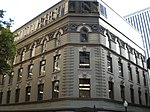Haleʻākala
1850s architecture1850s establishments in Hawaii1900 disestablishments in HawaiiHouses in Honolulu County, Hawaii

Haleʻākala, later renamed ʻAikupika, and then the Arlington Hotel, was a historic structure in Honolulu, Hawaii, which was the home of various prominent Hawaiians, and later became a hotel, and the initial headquarters of the American military forces involved in the overthrow of the Kingdom of Hawaii.
Excerpt from the Wikipedia article Haleʻākala (License: CC BY-SA 3.0, Authors, Images).Haleʻākala
Bishop Street, Honolulu Hawaii Capital Historic District
Geographical coordinates (GPS) Address Nearby Places Show on map
Geographical coordinates (GPS)
| Latitude | Longitude |
|---|---|
| N 21.3085 ° | E -157.8615 ° |
Address
S Hotel St + Bishop St
Bishop Street 1088
96813 Honolulu, Hawaii Capital Historic District
Hawaii, United States
Open on Google Maps









